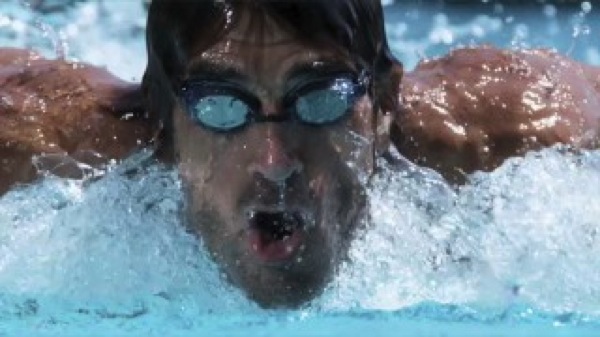
Below is an article I recently wrote for the newly launched SwimSwam.com– the new destination for all things swimming founded by my buddy Mel Stewart. A former world-record holder and two-time Olympic gold medalist in swimming, Mel is quite simply one of the greatest butterfly swimmers of all time. Period. But more than that, he is a great guy who continues to do great things for the sport of swimming. So do me a favor – swing by SwimSwam and check it out. Only weeks after it’s launch, it’s already taken over as the most popular online destination for up-to-the-minute news in the world of competitive swimming.
I hope you enjoy the article – the first in a series I will be writing specifically for triathletes looking to take their swimming to the next level.
The vast majority of triathletes and masters swimmers just can’t swim very well. And are clueless when it comes to training properly. Sorry people, it’s just a fact.
But let’s be honest, it’s not their fault. Unlike the many “born swimmers” covered here on SwimSwam – the genetically gifted few who began honing proper technique around the time they learned how to walk, most triathletes and masters swimmers stumble into swimming much later in life without any real background in our beloved sport. Ask any masters coach and they will tell you the same thing: teaching someone in middle-age how to swim correctly is a herculean task. Put another way, a child can quickly pick up Chinese when immersed in the language. But try learning this exotic tongue in your thirties and you’re looking at a lost decade.
But not all hope is lost. One of the biggest stumbling blocks preventing triathletes from improving upon their swim is a commonly held but misdirected belief that fitness trumps all. Just muscle through it and get it over with so I can get on my bike. With demanding schedules that leave only small windows to train – more often than not without the aid of a decent, focused coach or masters program — these athletes hit the pool with only one thought in mind: throw down as much hard volume as possible within the limited time allotted. Drills? Forget it. Intervals? I don’t know what you’re talking about. Who has time for technique? My Ironman is in 2 months and I’m terrified I won’t be able to finish the 2.4 mile distance!
Believe me, as a time-pressed triathlete myself, I’m sympathetic. But before I was a triathlete, I was a swimmer, competing in the 200 fly for Stanford back in the late 1980’s. So I have a swimmer’s perspective when it comes to physically and mentally preparing for the treachery of facing the open water. I’m here to tell you that the aforementioned misconceptions are some of the biggest impediments to improving your swimming acumen – stunting improvement, leading to implacable plateaus and generally culminating in a frustrated and discouraged athlete.
With this column, I will be sharing tips and strategies to help you break those bad habits and rewire how you think about your training so you can break that glass ceiling, conquer your fear of the open water, and ultimately make the swim work for you, rather than against.
For today, I will leave you with this one simple yet critical piece of advice based on my experience. Develop a willingness to let go of that overriding obsession with fitness and take the time to prioritize proficient technique first. When I work with masters swimmers and triathletes, I throw fitness right out the window and spend weeks, sometimes months, focused solely on improving and refining technique and technique alone. Because you simply cannot build a house without a solid foundation.
If you are struggling with your stroke, take a deep breath and slow down. I know it’s scary, but in order to realize a quantum leap in performance, it’s important to de-prioritize fitness and yardage for the time being and channel all that type-A personality and ferocity that attracted you to triathlon in the first place and redirect it towards improving fundamental mechanics. Rethink your approach to stroke drills – rather than considering them a welcome “break” from the harder set work, attack them with the same focus and intensity you would approach a set of hard 200’s. Swim alone? Have your stroke repeatedly videotaped and critiqued by someone who knows their stuff. And finally, find in a coach who can devote time and attention required to “get it right.” In the long run, this investment will pay time improvement dividends far beyond that set of expensive carbon Zipp wheels you treasure.
Rich is a two-time top finisher at the Ultraman World Championships in Hawaii, a double ironman distance triathlon that involves a 6.2 mile open water swim, 260 miles of cycling and culminates with a 52.4 mile run. In 2009 and 2011 he clocked the fastest swim splits, including the 4th fastest swim of all time in the event’s 26 year history – at age 45.
For more information on Rich, visit his website at richroll.com and follow him on Twitter at @richroll.
Rich’s inspirational memoir FINDING ULTRA (Crown / Random House) hits bookshelves May 22, 2012. Pre-oder now!. For more information on the book and Rich, visit richroll.com.
And check out Rich and his wife Julie’s plant-based e-cookbook JAI SEED – a beautiful coffee-table style cookbook for the digital iPad set that contains 77 glossy pages of plant-based nutrition information and easy to prepare recipes certain to satisfy even the most finicky family member.


When is the next article, Rich? How often will these come out? I have my first half-Ironman on Oct 28 in Miami, FL. Just started in the pool a month ago. The quicker you give me some help, the less bad habits I’ll develop. I can handle the length, 1.2 miles, due to fitness, but don’t know much about technique. Right now I’m thinking these thoughts as I swim: eyes looking at bottom of pool, don’t lift head when breathing, just rotate body, slide hand into water like putting it in a mail slot, catch, pull, follow all the way through, arm at steep angle – flutter kick like a scuba diver with fins. Ben Greenfield told me to use the swimsmooth.com website. So, that’s where I’m starting, You agree??
Great article. Thank you 😉